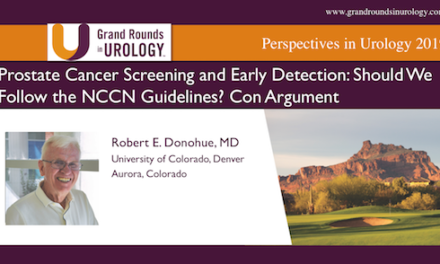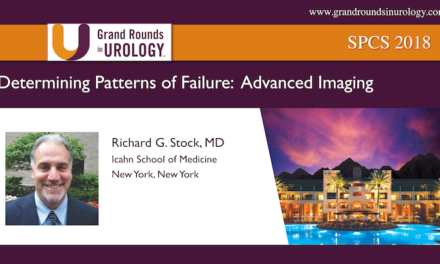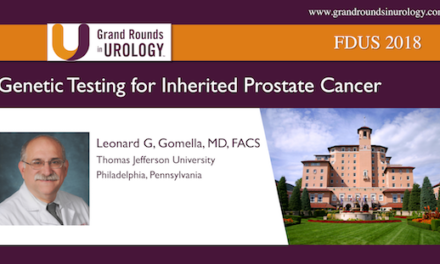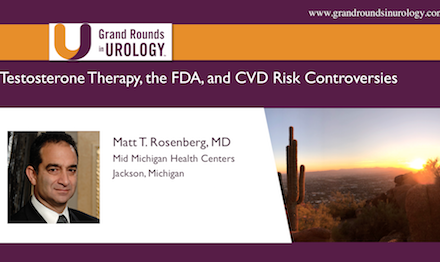Dr. Michael K. Brawer spoke at the 25th International Prostate Cancer Update on Thursday, January 22, 2015 on “The Last 25 Years of PSA.”
Presentation
“
Keywords: prostate cancer, PSA, prostatectomy, assay
How to cite: Brawer, Michael K. “The Last 25 Years of PSA.” Grand Rounds in Urology. March 10, 2015. Accessed Dec 2024. https://dev.grandroundsinurology.com/prostate-cancer-michael-k-brawer-last-25-years-psa/.
Transcript
The Last 25 Years of PSA
What I’m going to try to do is tell you where PSA has gone from my perspective in the years that the IPCU has met over 25 years, analyte that has revolutionized this disease and certainly almost caused a revolution.
I’m going to do this and I’m sure I’m going to miss some of your favorite papers. I’m going to take the most important paper that I see through the years since 1991, but we have to begin at the beginning. A lot of this work was started in Roswell Park under the tutelage of Gerald Murphy seen here. The important early work included albums identifying a protein that ultimately was shown on 2-D gel and eventually that was PSA.
Hara described it as gamma seminal protein. Li and Beling were able to purify this protein from the seminal plasma. Wang purified it from prostate, which is really a seminal event–no pun intended–in the development of this. Nadji and associates were the first to describe the relationship of PSA to prostate cancer. We heard a lot about Hans Lilja’s very important work that really begins in ’85 when he characterized the different subsets. Then in 1986 Hybritech and Myrtle were the first to develop a commercially-available assay not for screening, but for monitoring the disease. Later that year, FDA approval was granted.
I owe very much to these two people. Dr. Stamey was my mentor/guide, oftentimes adversary as we went through this process. But in 1987 he published at that point certainly the most important paper on PSA in the New England Journal where he looked at very carefully its role in prostate cancer. Again, no mention and no consideration that it would ever be useful as a diagnostic or screening test.
One of my old bosses, Paul Lange, contributed greatly in this arena. He was able to characterize the fall of PSA after successful radical prostatectomy, it’s most definitive use at that time.
Very, very important. I could put Crawford on every one of these slides for some aspect, but I’ll highlight what he really did with Prostate Cancer Awareness Week and development of PCEC. He and his team brought the whole issue of prostate cancer awareness to a forefront and coupled that certainly with the development of PSA.
In 1989 I was skeptical. I had left Stanford. Stamey kept saying it will never be used for early detection screening. Nagle and I published a paper when I was at the University of Arizona that said if you only had BPH or BPH with chronic inflammation, you didn’t have an elevated PSA when you underwent simple prostatectomy. There was always some other perturbation. That was the inkling that I had that said maybe everyone who said this would never work for early detection might be wrong.
Bill Catalona beat us to press by a few months, but we both did very similar studies designed separately both funded by Hybritech. Remember, my hypothesis going into this was it would not work. Amazingly, our two papers showed essentially exactly the same results, detection rates of just over 3 and positive predictive values of a third. This was amazing when you remember at that point we were only doing six systematic sector cores.
At the conclusion of our first publication on this I wrote that which you see in red, which I’ll let you read. I worried partly because my hypothesis was not going to work, but I was concerned that we were going to over-detect that disease. I guess we’ve seen it. Once we had PSA, we wanted to make it better. Everyone tried to improve on PSA and there was a lot of work. Joe Oesterling was very instrumental in developing age-specific PSA. Bruce Dalkin at Arizona in the same year published very similar results.
It was obvious the older you were, your PSA was going up for a lot of reasons. They decided to use different thresholds at different ages. The problem they failed to recognize was that prostate cancer also was going up. If you corrected for age by PSA, you missed more cancers in the patients that were most likely to have it.
Bal Carter and the group at Brady Hopkins did really a very important study with the Baltimore longitudinal aging cohort that taught us that the change in PSA over time was extremely helpful. It also reminded us why we took calculus in college.
We did the first study at Washington now and Semjonow in Europe showed the cacophony of results one could get when you measure the same serum with different assays. We had a big problem in the United States. Ultimately we corrected it. The problem in Europe was disastrous where you could get four-fold differences in PSA levels just by looking at a different assay.
Alan Partin of course is here. You can a concentration as he’s playing a beer game here, but Partin contributed so much over the years to this analyte. I think ultimately–and this is the topic of his presentation here–it was the combination of PSA clinical stage and Gleason score, the so-called Partin tables, that really made us think we need to integrate all these.
Following the work of Lilja, Catalona did a lot of work and ran the international study on the free PSA showing free to total PSA ratio was very important and was a discriminated cancer from not much better than total PSA. We were able to show the same results with complex PSA with only a single analyte. Then Slawin and Mikolajczyk looked at BPSA, which you’ll hear more about as we move forward.
Well, things got a little topsy turvy and we entered very troubled seas with a paper by Etzioni in 2002 who first raised the siren call that we may have a problem with over-detection of prostate cancer. The rest we know. Yves Fradet, Schalken, and our good friend Frans Debruynea did a lot of work telling us that urine could be another good analyte and develop the then called UPM3. Now we know it is PSA3.
Of course we all know the great work of Thompson in the prostate cancer prevention trial. One of the most important results out of that trial showed that there was a lot of cancer in men who had PSA less than 4.
Groskopf was able to add the very important instrumentation. All the manufacturers in the audience, you’ve got to get a test that you can run on instruments in the modern era and are president kind of alluded to some of this in his talk. We’ve got a movement in this direction. He made a reliable assay for PSA that could be instrumented.
My old partner Bill Ellis taught us about the ultrasensitive PSA from monitoring after radical prostatectomy. It was a harboring of early evidence of recurrence. Whether it really made some clinical sense remains unknown.
2009, a clearly important year because two seminal papers were published back to back in the New England Journal. The ERSPC study. PSA screening works in Europe, particularly as you see in Sweden. Our good friend, Jerry Andriole, the PLCO, very instrumental in this study again, showing it didn’t change survival.
Controversy. Lots of studies are controversial as we’ll see. The Hugosson study is the best part I think of the European trial, which was published separately that has the biggest effect, but it’s a very different kind of population in Sweden where there still is the highest prostate cancer mortality in the world. Whether these studies can really be extrapolated into a heavily-screened U.S. population remains to be seen.
We kept trying to make PSA better. Again, Bill Catalona with the Phi test prostate health index. You can see clear improvement over PSA in black and the receiver operating curve. More calculus again was a problem.
2012, an important year in my life. We published finally the PIVOT results. You know the controversy associated with this study. It didn’t improve all cause or disease-specific mortality, but since we’re talking to PSA, it did eloquently I think show that if all you knew about a man was he had cancer and the PSA was greater than 10, he did accrue a significant benefit both in disease specific and overall mortality if he had a radical prostatectomy. Again, PSA came back.
Later that year we got the D from U.S. Preventive Task Force, a crazy grade, a crazy analysis, etc, etc, but we’ve lived with it ever since.
Parekh last year published on the OPKO. The four-case score came out of Scardino and Lilja. A very important improvement in adding dramatically overall performances show in the RLC curve when you look at both free total and HK2, and put it into a very sophisticated algorithm to do that.
I will give you my slight perspective of where I think we’re going in the next 25 years. This quote from Einstein teaches us a lot. I think those of us that are students of this disease always need to remember this.
Here’s what I think will happen in 2015 and beyond. I think we’re going to continue. I hope we’re going to continue to be able to test men for prostate cancer probably initially with PSA, but I think, and we’re seeing it now, we’re going to do rational testings.
The VA was testing 85-year-olds in congestive failure. That has made amazing strides because of a very good integrated electronic healthcare network of not testing men who shouldn’t be tested. We need to extrapolate that to all testing.
I think we’re going to do more assessment early on in the young men with PSA and potentially with genetic markers that will identify a cohort of men that need more vigorous screening or early detection programs and people that probably don’t need to be tested after initial testing. We’ll personalize the follow up as we get more sophisticated, looking at things like velocity and change, but we’re going to move away from serial annual testing, repeat biopsy, and everything else because it’s crazy the way we’re applying it.
There will be more specific assays. I think the Phi test and the 4K test certainly show good promise. Scott mentioned the tremendous changes we’re seeing in Gleason and the use of molecular testing once prostate cancer has been diagnosed. I think we’re going to move more and more into the future with rational therapy. Ultimately our goal has to be to identify the right person with prostate cancer and give the right treatment to that person at the right time.
References
Andriole GL, Crawford ED, Grubb RL 3rd, et al. Mortality results from a randomized prostate-cancer screening trial. N Engl J Med. 2009 Mar 26;360(13):1310-9.
http://www.ncbi.nlm.nih.gov/pubmed/19297565
Brawer MK, Rennels MA, Nagle RB, et al. Serum prostate-specific antigen and prostate pathology in men having simple prostatectomy. Am J Clin Pathol. 1989 Dec;92(6):760-4.
http://www.ncbi.nlm.nih.gov/pubmed/2480060
Catalona WJ, Partin AW, Sanda MG, et al. A multicenter study of [-2]pro-prostate specific antigen combined with prostate specific antigen and free prostate specific antigen for prostate cancer detection in the 2.0 to 10.0 ng/ml prostate specific antigen range. J Urol. 2011 May;185(5):1650-5.
http://www.ncbi.nlm.nih.gov/pubmed/21419439
Chevli KK, Duff M, Walter P, et al. Urinary PCA3 as a predictor of prostate cancer in a cohort of 3,073 men undergoing initial prostate biopsy. J Urol. 2014 Jun;191(6):1743-8.
http://www.ncbi.nlm.nih.gov/pubmed/24333241
Schröder FH, Hugosson J, Roobol MJ, et al. Screening and prostate-cancer mortality in a randomized European study. N Engl J Med. 2009 Mar 26;360(13):1320-8.
http://www.ncbi.nlm.nih.gov/pubmed/19297566
Wilt TJ, Brawer MK, Jones KM, et al. Radical prostatectomy versus observation for localized prostate cancer. N Engl J Med. 2012 Jul 19;367(3):203-13.
http://www.ncbi.nlm.nih.gov/pubmed/22808955
ABOUT THE AUTHOR
Dr. Brawer, MD, is Vice President of Medical Affairs for Urology at Myriad Genetics Laboratories in Salt Lake City, Utah. Dr. Brawer joined Myriad from GTx, Inc., where he served as Executive Director of Medical Affairs and Clinical Development from 2009 until 2012. Prior to this, he was Chief Medical Officer at Tokai Pharmaceuticals from 2007 until 2009, and from 2006 to 2007, Dr. Brawer was Interim Chief Medical Officer at Threshold Pharmaceuticals.
In 1998, he helped found the Northwest Prostate Institute, a community hospital focused on clinical practice, community outreach, basic and clinical research, and medical education, and served as Director until 2007. From 1986 to 1998, he held various academic appointments, first at the University of Arizona and then at the University of Washington where he was Professor of Urology and Adjunct Professor of Pathology.
Dr. Brawer has published more than 200 scientific papers, 10 books, and 74 book chapters and is the recipient of 28 peer-reviewed competitive grants. In 1998, the American Urological Association bestowed upon him the Gold Cystoscope, given annually to a urologist distinguished by outstanding contributions to the profession within 10 years of completion of residency training.
Dr. Brawer received his bachelor and medical degrees from the University of California, Los Angeles, where he also completed a fellowship in pathology. He completed his residency in urology at Stanford University Medical Center, where from 1985 to 1986 he was Chief Resident in Urology.





